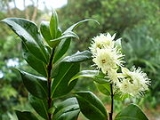
Cinnamon Myrtle
Encyclopedia
Backhousia myrtifolia is a small rainforest
tree species grows in subtropical rainforests of Eastern Australia
. B. myrtifolia is also known as carrol, carrol ironwood, neverbreak, ironwood or grey myrtle, or Australian lancewood. Cinnamon myrtle is a spice
form of B. myrtifolia.
Backhousia myrtifolia can grow up to 30 metres. The leaves are ovate or elliptic, 4-7 cm long, with a cinnamon-like odour. Flowers are star-shaped and borne in panicles. The small papery fruit are bell-shaped.
variant used as a flavouring spice. However, the name 'cinnamon myrtle' is now used to describe the species in general.
Cinnamon myrtle is part of a group of related Myrtaceae
family members that were popularized as spices in Australian bushfood
cuisine in the late 1980s and early 1990s. This group of plants also includes lemon myrtle
(Backhousia citriodora) and aniseed myrtle
(Syzygium anisatum).
Rainforest
Rainforests are forests characterized by high rainfall, with definitions based on a minimum normal annual rainfall of 1750-2000 mm...
tree species grows in subtropical rainforests of Eastern Australia
Australia
Australia , officially the Commonwealth of Australia, is a country in the Southern Hemisphere comprising the mainland of the Australian continent, the island of Tasmania, and numerous smaller islands in the Indian and Pacific Oceans. It is the world's sixth-largest country by total area...
. B. myrtifolia is also known as carrol, carrol ironwood, neverbreak, ironwood or grey myrtle, or Australian lancewood. Cinnamon myrtle is a spice
Spice
A spice is a dried seed, fruit, root, bark, or vegetative substance used in nutritionally insignificant quantities as a food additive for flavor, color, or as a preservative that kills harmful bacteria or prevents their growth. It may be used to flavour a dish or to hide other flavours...
form of B. myrtifolia.
Backhousia myrtifolia can grow up to 30 metres. The leaves are ovate or elliptic, 4-7 cm long, with a cinnamon-like odour. Flowers are star-shaped and borne in panicles. The small papery fruit are bell-shaped.
Essential oil
The name 'cinnamon myrtle' was originally coined in the late 1980s to describe a specific elemicinElemicin
Elemicin is a phenylpropene, a natural organic compound, and is a constituent of the essential oil of nutmeg.Elemicin is also a minor constituent of the oleoresin and essential oil of Manila elemi...
variant used as a flavouring spice. However, the name 'cinnamon myrtle' is now used to describe the species in general.
Cinnamon myrtle is part of a group of related Myrtaceae
Myrtaceae
The Myrtaceae or Myrtle family are a family of dicotyledon plants, placed within the order Myrtales. Myrtle, clove, guava, feijoa, allspice, and eucalyptus belong here. All species are woody, with essential oils, and flower parts in multiples of four or five...
family members that were popularized as spices in Australian bushfood
Bushfood
Bushfood traditionally relates to any food native to Australia and used as sustenance by the original inhabitants, the Australian Aborigines, but it is a reference to any native fauna/flora that is used for culinary and/or medicinal purposes regardless of which continent or culture it originates...
cuisine in the late 1980s and early 1990s. This group of plants also includes lemon myrtle
Lemon myrtle
Backhousia citriodora is a flowering plant in the family Myrtaceae, genus Backhousia. It is endemic to subtropical rainforests of central and south-eastern Queensland, Australia, with a natural distribution from Mackay to Brisbane...
(Backhousia citriodora) and aniseed myrtle
Aniseed myrtle
Syzygium anisatum , ringwood or aniseed tree is a rare Australian rainforest tree with an aromatic leaf that has an essential oil profile comparable to true aniseed...
(Syzygium anisatum).
External links
- Plant profile, including cultivation requirements http://www.daleysfruit.com.au/CINNAMON-MYRTLE,--Backhousia-myrtifolia.htm

